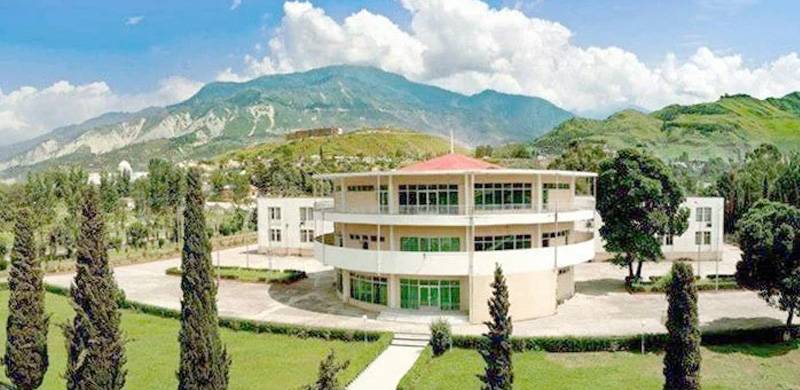
Despite the centrality of the dispute of Jammu & Kashmir in the political, economic and diplomatic discourse of the mainland Pakistan—socio-economic development of Azad Jammu & Kashmir (AJK) remains a footnote in the larger scheme of things in Pakistan. Substantive discussion on economic development is conspicuous due to its absence in AJK. As a result, evidence based economic policy making remains elusive. In this article we contextualize the socio-economic processes in AJK against the backdrop of broader structural forces. In particular, we take a stock of the public sector spending during the period 1997 to 2018 to critically assess its impact on socioeconomic development of AJK and to identify sectors which tends to be consistently neglected. The purpose of this exercise is not just academic but to initiate a broader dialogue on a way forward so that AJK can get on the path of inclusive and sustainable economic development. Access to decent employment opportunities is one of the core indicators of gauging the health of an economy. So, it is imperative to start with employment indicators.
AJK’s labor force participation rate—it shows how much of the country’s working age population is employed or looking for employment—is only 22.9% percent which is almost half of Pakistan’s national average.
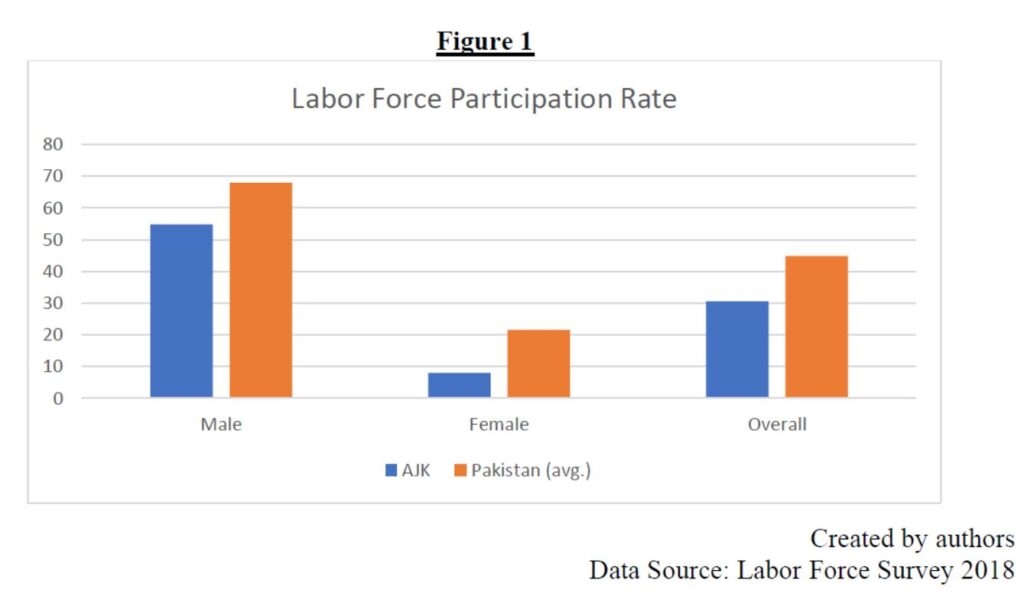
It is important to point out that female labor force participation rate of Pakistan is one of the lowest in South Asia. But the situation in AJK is extremely gloomy as female labor force participation rate is only 7.9 percent as compared to Pakistan’s average of 23 percent. Huge gender disparity in terms of labor force participation rate reflects underlying gender hierarchies and gender-based discrimination in AJK. Similarly, unemployment rate has been consistently high in AJK. According to official estimates, unemployment rate stands at 11 percent which is twice of Pakistan’s national average.
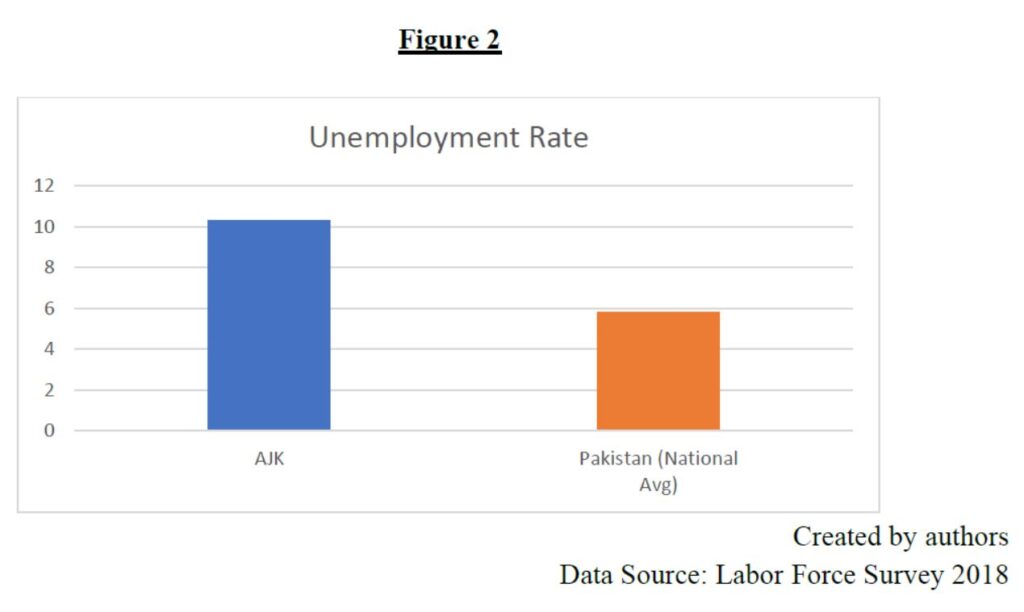
Official unemployment rate does not tell us the full gravity of the situation in AJK, in particular the issue of underemployment. Moreover, despite the low female labor force participation rate, female unemployment rate is 23 precent (see figure 3).
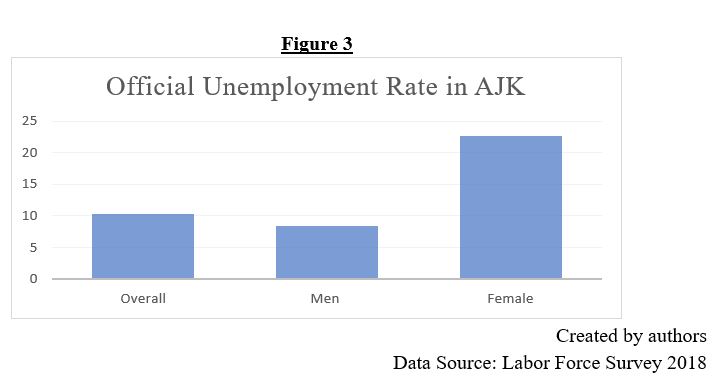
Similarly, youth (15-29 years old) unemployment rate is 27 percent. Therefore, the overall unemployment rate does not tell us the systemic inequities within the AJK’s labor market across the lines of gender and age. In order to ameliorate the current situation, first and foremost it is important to analyze which sectors are employing people and where does the future potential lie?
Agriculture (including forest and fishery) sector has the highest share in total employment, followed by construction, wholesale & retail trade, manufacturing and transportation sectors (see figure 4). Whereas, the average share of agriculture in the total budget of AJK has been hovering around one percent since 1997 (see figure 5). Moreover, absence of affordable institutional credit to small and medium size farmers has severely restricted new investments in the agriculture sector of AJK.
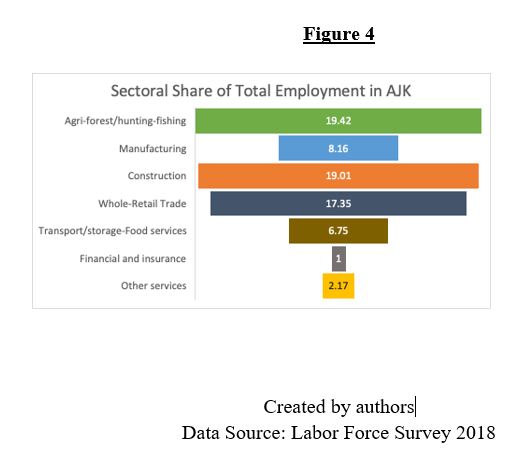
Furthermore, inadequate modern storage facilities have been a major bottleneck to develop an effective network of the supply chain in AJK. Private sector investments are limited in AJK’s productive infrastructure, and therefore, public sector has to take a lead. But unfortunately, there has been a steady decline in the share of rural development budget during 1997 to 2018, as it is merely a 2.6 percent of the total budget (see figure 5).
One of the biggest potentials of the AJK is its tourism sector. It can generate new jobs and economic activity in the region. But the tourism sector on average has received only 0.27 percent of the total budget in the past twenty years, and this explains why tourism in AJK is ‘under-developed’ (see figure 5).
Underinvestment in agriculture, rural development and tourism have collectively created a crisis of unemployment in AJK. While, middle and old age men have been moving overseas to find employment, whereas, women and young people of AJK are stuck at home without decent employment opportunities. This ‘reserve army of young unemployed people’ is likely to grow at a higher rate in coming years. To state the obvious, it can have a devastating impact on the socioeconomic fabric of the society as overseas employment, especially in Gulf countries is likely to slow down in future.
Therefore, it is imperative on policy makers to move away from the business-as-usual approach, and prioritize policies that can create new employment opportunities in AJK, especially for women and young people.
Three-tiered strategy— short-term, medium-term and the long-term—is required to bring about a substantive and sustainable improvements in the local economy. Public spending should be channeled towards productive sectors to create a multiplier effect in the economy. Priority should be given to agriculture and associated small-scale homemade industries which can create a series of forward and backward linkages in the economy. Development of tourism requires time as infrastructure development cannot be bought from shelves. By learning from the regional experiences, it is important to keep in mind that tourism is a double edge sword. On the one hand, it has a potential to generate new economic activity in the region for historically disadvantaged groups, but it can also bring ecological degradation and pollution, if left to the market forces alone.
Therefore, out of box thinking is required to transform the socioeconomic landscape of AJK. Negative social and ecological impacts of ‘development’ can be countered by promoting community based ‘cooperative enterprises’ that do not simply maximize the short-term profits but have a long-term commitment towards the wellbeing of the local community and ecology.
But this does not only require a structural shift in the economic thinking of policy makers but it mandates a popular pressure from below to push for gender equity, economic fairness and ecological sustainability.
Authors Bio:
Twitter: @khandahnish
Email: dkhan@fandm.edu
AJK’s labor force participation rate—it shows how much of the country’s working age population is employed or looking for employment—is only 22.9% percent which is almost half of Pakistan’s national average.

It is important to point out that female labor force participation rate of Pakistan is one of the lowest in South Asia. But the situation in AJK is extremely gloomy as female labor force participation rate is only 7.9 percent as compared to Pakistan’s average of 23 percent. Huge gender disparity in terms of labor force participation rate reflects underlying gender hierarchies and gender-based discrimination in AJK. Similarly, unemployment rate has been consistently high in AJK. According to official estimates, unemployment rate stands at 11 percent which is twice of Pakistan’s national average.

Official unemployment rate does not tell us the full gravity of the situation in AJK, in particular the issue of underemployment. Moreover, despite the low female labor force participation rate, female unemployment rate is 23 precent (see figure 3).

Similarly, youth (15-29 years old) unemployment rate is 27 percent. Therefore, the overall unemployment rate does not tell us the systemic inequities within the AJK’s labor market across the lines of gender and age. In order to ameliorate the current situation, first and foremost it is important to analyze which sectors are employing people and where does the future potential lie?
Agriculture (including forest and fishery) sector has the highest share in total employment, followed by construction, wholesale & retail trade, manufacturing and transportation sectors (see figure 4). Whereas, the average share of agriculture in the total budget of AJK has been hovering around one percent since 1997 (see figure 5). Moreover, absence of affordable institutional credit to small and medium size farmers has severely restricted new investments in the agriculture sector of AJK.

Furthermore, inadequate modern storage facilities have been a major bottleneck to develop an effective network of the supply chain in AJK. Private sector investments are limited in AJK’s productive infrastructure, and therefore, public sector has to take a lead. But unfortunately, there has been a steady decline in the share of rural development budget during 1997 to 2018, as it is merely a 2.6 percent of the total budget (see figure 5).
One of the biggest potentials of the AJK is its tourism sector. It can generate new jobs and economic activity in the region. But the tourism sector on average has received only 0.27 percent of the total budget in the past twenty years, and this explains why tourism in AJK is ‘under-developed’ (see figure 5).
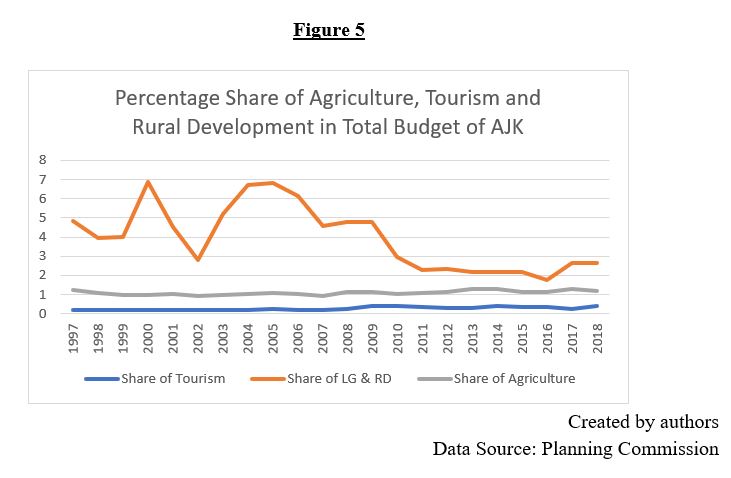
Underinvestment in agriculture, rural development and tourism have collectively created a crisis of unemployment in AJK. While, middle and old age men have been moving overseas to find employment, whereas, women and young people of AJK are stuck at home without decent employment opportunities. This ‘reserve army of young unemployed people’ is likely to grow at a higher rate in coming years. To state the obvious, it can have a devastating impact on the socioeconomic fabric of the society as overseas employment, especially in Gulf countries is likely to slow down in future.
Therefore, it is imperative on policy makers to move away from the business-as-usual approach, and prioritize policies that can create new employment opportunities in AJK, especially for women and young people.
Three-tiered strategy— short-term, medium-term and the long-term—is required to bring about a substantive and sustainable improvements in the local economy. Public spending should be channeled towards productive sectors to create a multiplier effect in the economy. Priority should be given to agriculture and associated small-scale homemade industries which can create a series of forward and backward linkages in the economy. Development of tourism requires time as infrastructure development cannot be bought from shelves. By learning from the regional experiences, it is important to keep in mind that tourism is a double edge sword. On the one hand, it has a potential to generate new economic activity in the region for historically disadvantaged groups, but it can also bring ecological degradation and pollution, if left to the market forces alone.
Therefore, out of box thinking is required to transform the socioeconomic landscape of AJK. Negative social and ecological impacts of ‘development’ can be countered by promoting community based ‘cooperative enterprises’ that do not simply maximize the short-term profits but have a long-term commitment towards the wellbeing of the local community and ecology.
But this does not only require a structural shift in the economic thinking of policy makers but it mandates a popular pressure from below to push for gender equity, economic fairness and ecological sustainability.
Authors Bio:
- Danish Khan is Assistant Professor of Economics and Co-Director of ‘The Inequality, Poverty, Power & Social Justice Initiative’ at Franklin & Marshall College, USA.
Twitter: @khandahnish
Email: dkhan@fandm.edu
- Aiza Ashraf is ‘Director of Equity’ in a Non-Profit Organization in the USA. She works on issues related to socio-economic mobility of historically marginalized groups.

